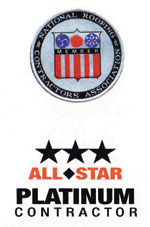Removing Snow From Your Commercial Roof
 This winter has meant serious snow accumulation in most of New Jersey. With another storm on the way, it is important to think about removing snow from your commercial roof. Heavy snow and ice can cause major damage to the surface of your roof, while melting water can easily penetrate the roof system causing leaks and potential damage below. Of course, the worst case scenario would be a building collapse caused by the excessive weight of packed snow.
This winter has meant serious snow accumulation in most of New Jersey. With another storm on the way, it is important to think about removing snow from your commercial roof. Heavy snow and ice can cause major damage to the surface of your roof, while melting water can easily penetrate the roof system causing leaks and potential damage below. Of course, the worst case scenario would be a building collapse caused by the excessive weight of packed snow.
Commercial flat roofs, lower roofs that meet higher roofs, and areas with parapets or areas of drifting snow are major concerns. Removing snow from roofs will minimize the likelihood of structural collapse. Flat and low pitched roofs, are at the greatest risk of buckling under heavy snow and ice accumulations.
Before a Major Storm:
• Do a basic check of the ceiling and interior walls for signs of leaks. Stains on the ceiling are usually a good indication. Seal all possible leak points before the weather gets worse.
• Check the roof for any signs of deterioration. Remove all loose debris from roof surface. Remember: snow is heavy and an old, weak roof will have difficulty supporting it.
• Check expansion joints for signs of excessive movement, splits, thin sections of membrane, deteriorated caulking, and loose metalwork. Cold weather affects mortar and composite building materials by causing them to contract. If the materials are already loose, they will continue to separate, forming access points for water and wind into the facility.
• Check HVAC ductwork, housings, condensation lines, pipes, and curb flashings. The condition of this equipment will affect the
ability to keep heat in the facility.
• Check all roof penetrations for damage. Any point of air or water infiltration needs to be restored to a properly sealed condition.
• Check and clear drainage gutters, downspouts, and scuppers. Clean out all drains, and make certain they are working properly.
After a Major Storm:
• Use a snow rake for pitched roofs (available at most hardware stores) to remove snow from your roof.
• Try to shave the snow down to 2 or 3 inches on the roof instead of scraping the roof clean, which will risk damage to your shingles or other roof covering.
• Keep in mind that any metal tool could conduct electricity if it touches a power line and metal tools may cause damage to the roof.
• Shovel snow from flat roofs throwing the snow over the side away from the building. Most plastic shovels are better, except for the ones with curved blades-those too will do some damage to your roof.
• Wear protective headgear and goggles when performing any of these tasks.
• Consider hiring professionals to do the job. The combination of heights plus ice makes a dangerous job
• Keep gutters, and drains clean, free of ice and snow and keep downspouts clean at ground level.





























